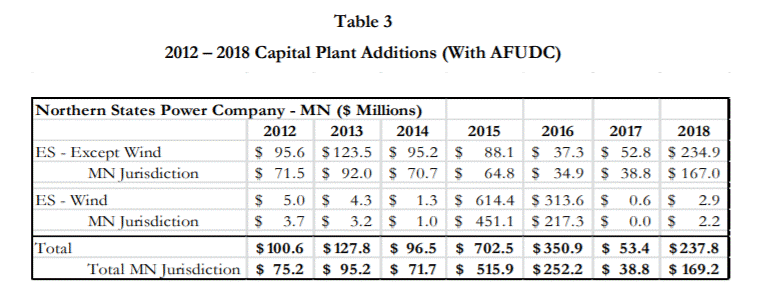Xcel has Been Increasing Rates to Pay for Expensive Wind Farms
If you’re an Xcel customer, you have most likely noticed your electricity rates have been increasing steadily in the last few years.
That’s because Xcel signed a historic multi-year rate plan in 2015 extending to 2018, increasing electricity rates for all Xcel customers. Spelled out directly in its rate-case, Xcel’s rate increases were implemented almost entirely to pay for expensive investments in wind energy and other power facilities, totaling over $1 billion, in order to comply with Minnesota’s Renewable Energy Standard (RES).
Here’s Xcel on the matter:
While multiple factors drive our overall request [for a rate increase], our capital investments in transmission, distribution, and generation is by far the largest component.
These capital investments were spent almost entirely on renewable energy sources. For 2015, Xcel explained its capital additions as such:
Our forecasted Renewable and Generation capital additions of $613.9 million in 2015 are for the Pleasant Valley and Border Winds wind projects.
And from 2016-2018, Xcel stated:
Virtually all of our Renewable and New Generation capital additions are associated with the major Courtenay Wind Farm (2016) and Black Dog 6 (2018) projects.
Despite being a natural gas facility, Black Dog Unit 6 was also designed for renewable energy purposes and is forecasted to cost over $110 million. As Xcel explained:
[The Black Dog Unit 6] project will provide additional fast response load-following capability to balance the output of our additional renewable wind generating assets.
Xcel has a historical capital budget of anywhere from $100 million to $125 million each year for capital plant additions. But as Xcel explains using the graph below, these numbers change when wind farm projects are added:

Th[is] table above illustrates that our capital expenditures typically remain within a range of $100 to $115 million but for the years in which we make major capital investments – as with Pleasant Valley, Border Winds, and Courtenay Wind in 2015 and 2016.
It is important to note that all other years included expenses related to repairs on the coal-fired generator Sherco Unit 3 and more. For example, Sherco 3 needed repairs in 2016 that required $9.2 million, and again in 2018 requiring $71.2 million. These repairs are far lower than the cost of building new wind farms, suggesting that maintaining our current system is the best solution for keeping electricity rates, and therefore bills, lower.
Even when comparing renewable capital additions to nuclear plant additions—which are filed separately—we see that we get more bang for our buck with energy sources other than wind.
For example, Xcel spent over $800 million on repairs to both Monticello and Prairie Island nuclear plants in 2013. The next year, these power plants together generated over 12,500,000 MWh of electricity. The $600 million investment on the Borders and Pleasant Valley wind farm in 2015, on the other hand, only yielded a combined 1,445,095 MWh of electricity in 2015. It would take nearly 9 years for these wind farms to generate the same amount of electricity.
Worse yet, on top of the enormous capital costs of building wind farms wind energy also imposes other costs on the energy system that aren’t so easy to predict. Here is Xcel’s explanation of imposed costs caused by wind energy in its 2010 rate case:
Since generation from wind cannot be easily predicted, our other non-wind generating units must cycle in order to accommodate the random influx of generation onto our system. This cycling results in more wear and tear on our generating units, which leads to higher O&M costs. As the wind generation increases to meet our RES Requirement, as well as other Minnesota utilities’ RES Requirements, we expect the cycling and corresponding O&M costs to steadily increase.
Wind energy is thus expensive for reasons beyond initial capital costs, and it’s also unnecessary. Electricity consumption in Minnesota has not increased since 2006, and the state already had existing energy sources able to meet energy demand.
The reason behind increasing electricity rates in Minnesota is clear: utility companies like Xcel Energy are building wind farms and natural gas facilities that Minnesotans don’t need in order to comply with state renewable energy regulations.